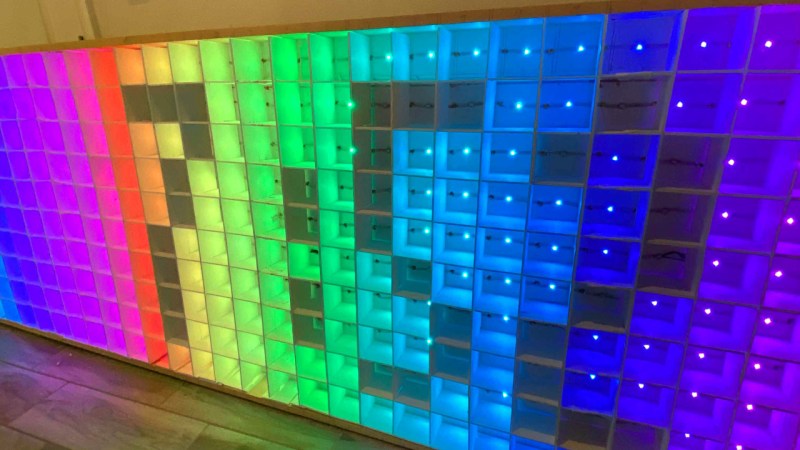We’ve all got one: a blank space somewhere in our home that we don’t know what to do with. [James Miller] had one above his kitchen cabinets, so he filled it with a giant LED matrix. The result is a large but surprisingly attractive LED screen that can send messages, provide illumination, or while away the idle hours of the night playing Conway’s Game of Life.
[James] built the matrix using the usual suspect for these builds: several strings of WS2812 lights . He initially ran this from a Raspberry Pi, but realized that there was no need for such a dizzying amount of computing power, so he switched to an ESP32 instead. The frame is built from wood and foam board.
The first version he built used a fabric diffuser, but after a close encounter with a flaming steak, he switched over to commercial ceiling light diffusers cut down to size. We might have been tempted to keep going and try an “egg crate” style ceiling light panel for a the smaller pixel size, but [James] thinks he has reached the “good enough” point of this project. It’s certainly a fun build, and it looks very cool with minimal materials.
















This is actually a surprisingly cool project! I never would have considered putting something like this in the kitchen, but it works so well, *and* looks plenty stylish to boot!
Wow, I thought the 1200 solders of my 10×20 Tetris grid was horrible to do, that’s almost twice the size, must have took forever to strip and solder those. I’d probably go with a standard strip LED spacing if I ever have to do that again.
I like the idea of a display high on a wall, especially if it was programmed to let me use it for timers. I don’t want to detract at all, but am I the only one who wistfully chuckled at the idea of having any free space in the kitchen?
Life is a fun application to use, but have to be careful to choose a starting configuration that lasts for a long time. Otherwise you’ll be staring at a static screen. R-Pentimino is a good one.
Or, just have it toggle a random cell every so often.
“We’ve all got one: a blank space somewhere in our home that we don’t know what to do with”
I don’t
Building one now! Just hotglued down the first 100 lights. It boggles the mind on how cheap the LEDs, power supplies, and WiFi microcontrollers have become. I think I’m at around $100 for this project, including the ESP-32 thats been idling on my desk forever and the hot snot gun I had to buy.
I recently did a project where I upgraded the old dead solar lights with ws2811 pixels – they’re actually really cheap to buy just as LEDs (I got the 8mm ones) knock together a pcb, have JLC knock out some pcbs, they only require a cap and resistor per pixel iirc, spend an afternoon with a hot plate throwing smd components down then solder up the leds (prolly just get smd leds honestly the pin pitch on the 8mm thru holes was a nightmare)